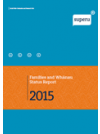The Families and Whānau Status Report is a series that aims to enrich our understanding of family and whānau wellbeing. Measuring family wellbeing is complicated, not just because there is no universally agreed definition of what we mean by family or wellbeing, but also because multiple and inter-related factors impact on the daily activities, functions and living arrangements of families.
The structure of families and whānau in New Zealand is changing. Current demographic trends such as smaller family sizes, increased longevity, relatively high fertility levels, higher rates of household formation and dissolution, are all part of the shifting demographic context. A rapidly changing society is also putting new pressures on families and whānau, making it important to review how well they are standing up to new economic and social circumstances, expectations and values.
Purpose
In the 2015 Families and Whānau Status Report, we present New Zealand family and whānau wellbeing indicators using family and whānau frameworks developed for this purpose. The findings have implications across the social sector and in particular for social development, housing, education, health, economic development and Māori development.
The frameworks are also separately presented in a smaller At A Glance publication.
The Technical Companion Report complements the Status Report and provides detailed information about how wellbeing indicators were selected, the full range of responses for these indicators, and includes case study vignettes.
The Research Summary provides a high-level overview of the research findings in main report.
At a Glance: Demographic overview of families in New Zealand uses data from the 2013 NZ Census to present a view of the nation’s families.

